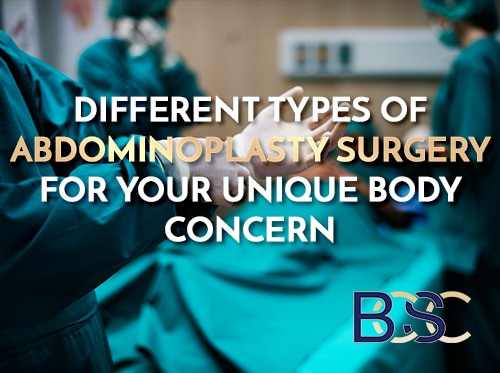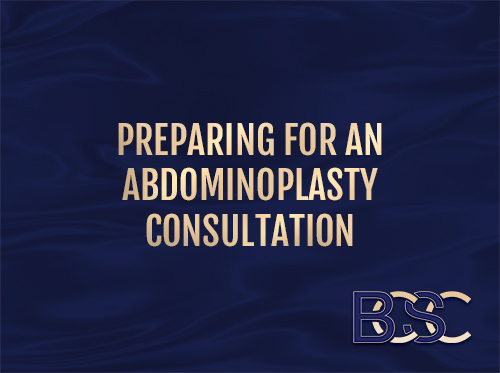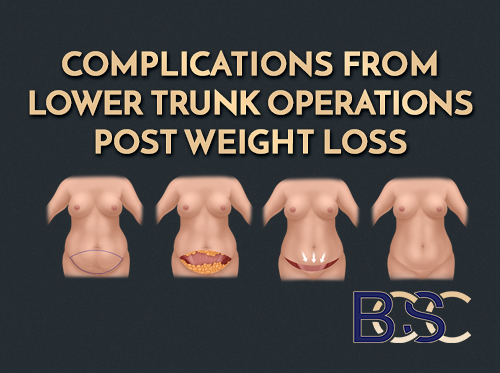Abdominoplasty Recovery & Downtime (Tummy Tuck – Abdominoplasty)
Recovery after abdominoplasty (tummy tuck) is a progressive process that unfolds over weeks and months. Most patients need two to three weeks of initial healing before resuming light activities. However, swelling and scars continue to settle for much longer. Residual swelling may last up to twelve to eighteen months, and scar maturation can extend to two years. Each patient’s recovery is unique, influenced by health, age, fitness, and whether abdominal muscle repair (diastasis recti) or ultrasound-assisted liposuction (VASER) was included in the operation.
Abdominoplasty is designed to remove redundant skin and fat and, when necessary, repair weakened abdominal muscles. It is not a substitute for weight loss. Suitable candidates are usually close to their goal weight and maintain stable health. Surgery does not prevent future changes, and results vary from person to person.
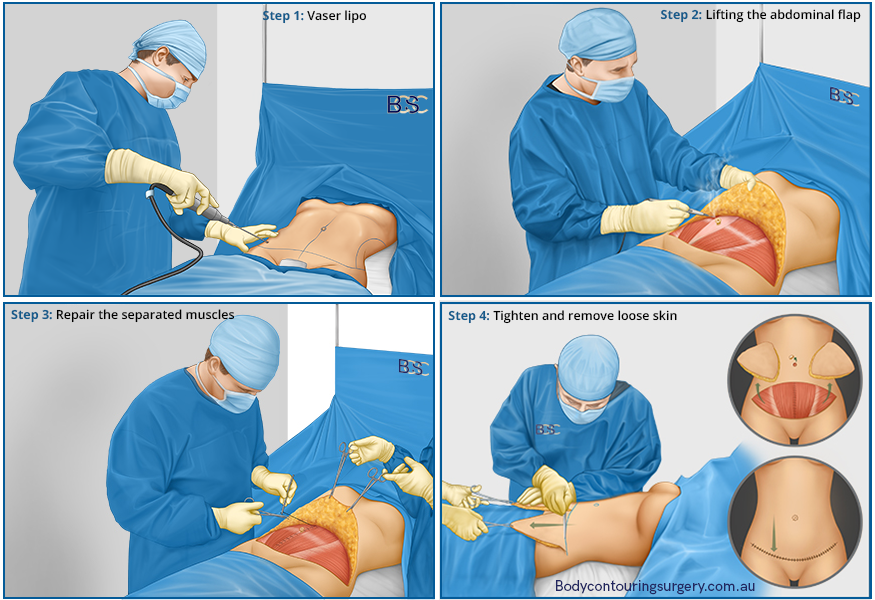
Factors that influence recovery
The recovery timeline is shaped by several elements. The type of abdominoplasty matters: a mini procedure, with less skin removal, usually allows faster return to work compared with an extended or circumferential operation. Adding muscle repair tends to prolong the period before strenuous activity. Health and age play roles too, with younger, fitter patients often recovering more quickly. Combining abdominoplasty with liposuction (Suction assisted lipectomy) can increase swelling and bruising, extending downtime. Finally, strict adherence to post-operative care — including compression, nutrition, and activity modifications — makes a significant difference.
Recovery timeframes
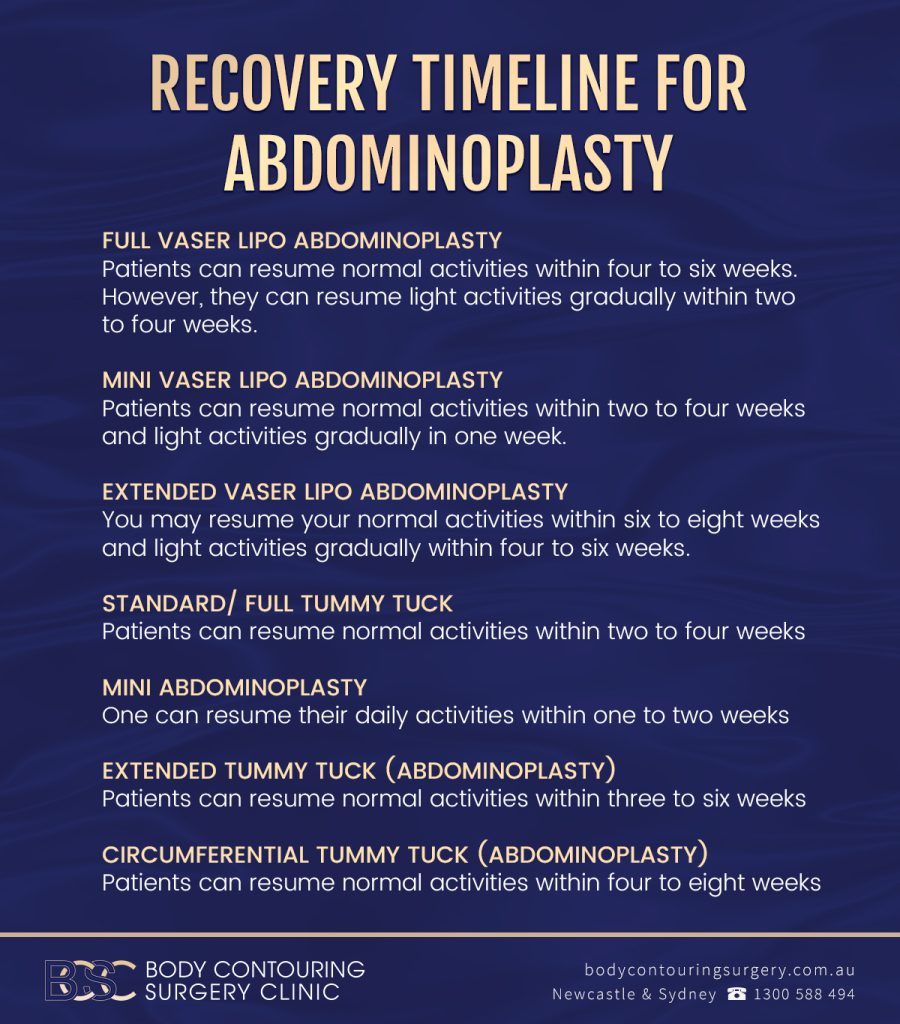
Different procedures have different expectations. A mini abdominoplasty usually allows a return to desk work within one to two weeks, while a full abdominoplasty often requires two to three weeks away from work and around four to six weeks before heavier activities. Extended procedures involving the abdomen, hips, and flanks may need six to eight weeks before full recovery, and circumferential abdominoplasty (body lift), which addresses the back and buttocks as well, often takes even longer. When VASER liposuction is added, bruising and swelling may be more pronounced, extending the recovery further.
These figures are guidelines. The actual pace of healing depends on the individual and the extent of surgery.
- Full Vaser Lipo Abdominoplasty: Patients can resume normal activities within four to six weeks. However, they can resume light activities gradually within two to four weeks.
- Mini Vaser Lipo Abdominoplasty: Patients can resume normal activities within two to four weeks and light activities gradually in one week.
- Extended Vaser Lipo Abdominoplasty: You may resume your normal activities within six to eight weeks and light activities gradually within four to six weeks.
- Standard/ Full : Patients can resume normal activities within two to four weeks
- Mini : One can resume their daily activities within one to two weeks
- Extended Tummy Tuck Abdominoplasty: Patients can resume normal activities within three to six weeks
- Circumferential Abdominoplasty: Patients can resume normal activities within four to eight weeks
Hospital stay
Length of stay varies with procedure. Many patients undergoing mini abdominoplasty go home the same day. After full or extended abdominoplasty, Dr Beldholm usually recommends at least two nights in hospital, sometimes up to four or five, depending on comfort and progress. Circumferential abdominoplasty often requires two to five nights or longer. This time allows patients to recover from anaesthesia and begin mobilisation while pain and nausea are closely monitored.
Recovery journey
The first week is the most intense. Pain usually peaks within the first two to three days but is managed with medication. Swelling, bruising, and tightness are expected. Dressings such as PICO remain in place for the first week and are changed by the nurse at day seven. Compression garments are worn continuously, and short, gentle walks begin almost immediately to reduce the risk of complications such as blood clots.
By the second week, discomfort begins to ease, though swelling remains. Many patients can return to light duties at this stage if their job is not physically demanding. In weeks three and four, bruising usually resolves and compression can often be reduced to daytime use. Gentle exercise such as walking can continue, though strenuous core activity must still be avoided if muscle repair was performed.
Between weeks four and eight, activity gradually expands. Swimming and gym work are often reintroduced once incisions are fully healed and the surgeon has given clearance. Most daily activities are comfortable by this stage, though swelling and scar firmness are still present.
Long-term healing continues for months. Around sixty percent of swelling settles by three months, with further improvement by six months. Final contour and scar maturation take twelve to eighteen months or longer.
Post-operative care
Wearing compression garments for about six weeks is standard, with the first two to three weeks being most critical. Incision care is simplified by negative-pressure dressings, which stay in place for the first week. Drains, if used, are usually removed within two to seven days. Antibiotics are provided intravenously during surgery, though routine oral antibiotics after discharge are generally not continued, in line with evidence-based practice.
Sleeping in a slightly reclined position with the knees bent can ease tension on the abdomen. Light walking is encouraged early, while strenuous activities are avoided until cleared. Adequate sleep, hydration, and nutrition all play important roles in recovery.
Pain and discomfort
Every patient experiences pain differently. Most find that discomfort peaks in the first few days and then improves steadily. Tightness is common, especially after diastasis recti repair, and may persist for six to twelve weeks. Pain medications are provided to manage symptoms during the early phase.
Recovery tips
Some general measures that support healing include maintaining a nutritious diet rich in protein and vitamins A and C, drinking plenty of water, wearing compression garments as advised, avoiding alcohol and smoking, and attending follow-up appointments. Gentle walking is encouraged, while strenuous movements, especially abdominal strain, must be delayed until your surgeon approves. Reporting unusual symptoms such as fever, increasing redness, or severe pain is essential for safety.
FAQs
How long should I take off work?
Most patients return to non-physical work within two to three weeks. Physical roles need longer and a staged return.
When will swelling settle?
The majority of swelling reduces within six to eight weeks, though refinement continues for up to eighteen months.
When can I drive?
Usually after two to three weeks, once you can move freely, brake safely, and are no longer taking sedating pain medication.
When can I swim?
Once wounds are fully sealed and cleared by your surgeon, usually after four to six weeks.
When can I resume sexual activity?
For smaller procedures, some patients resume after two weeks; for larger operations, at least four weeks is recommended, provided healing allows.
Risks and safety
As with all operations, abdominoplasty involves risks such as bleeding, seroma, infection, wound healing issues, clots, sensation changes, or unfavourable scarring. Risks depend on your health, procedure extent, and how well post-operative instructions are followed. Close follow-up allows early identification and treatment of complications.
Final results
Initial improvements are visible early, but the final outcome takes time. Swelling and scars evolve over many months. Most patients see the refined result around twelve to eighteen months, once tissues settle and scars mature. Patience is important, as recovery is a gradual process
References (selected, peer-reviewed)
- Winocour J, et al. Abdominoplasty. Plast Reconstr Surg. 2015;136(5):597e–606e.
- Vidal P, Berner JE, Will PA. Managing Complications in Abdominoplasty. Arch Plast Surg. 2017;44(5):457–468.
- Wu SS, et al. Liposuction: Concepts, Safety, Techniques. Cleveland Clinic J Med. 2020;87(6):367–375.
- O’Kelly N, et al. Standards & Trends in Lipoabdominoplasty. PRS Global Open. 2020;8(10):e3144.
- Kosloski FR, et al. Effect of Compression Garments after Abdominoplasty. Aesthetic Surg J. 2023.
- Brauman D, van der Hulst RRWJ, van der Lei B. Liposuction-assisted Abdominoplasty. PRS Global Open. 2018;6(9):e1940.
- Harris L, Darby P. Enhanced Recovery after Abdominoplasty with Nutrition. PRS Global Open. 2020;8(12).
